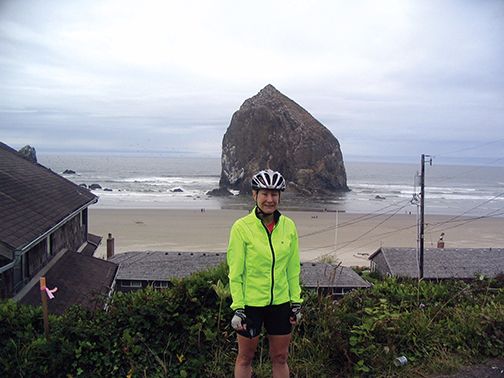Article by Kristin Knopf, Billings Middle School
Since I was a kid, I’ve had a passion for bicycling. My first bike was a spiffy red one that could go backwards because it had no brakes. In high school I was proud of being pulled over by the local police for speeding (granted, going downhill).
As an adult, I continued to ride occasionally. But the urge to ride remained, so my husband, Brian, and I bought bikes and began riding more.
My first month of serious riding was done secretly. As soon as Brian rode off to work at 6 a.m., I would hop on my bike, quickly working up to 20 miles, eventually learning to relish the long up-hill at the end.
In 2005, we went car-camping down the Oregon coast, our bikes on the back of our cargo van. At campgrounds, lighthouses and scenic overlooks, we kept meeting a German bicycle tourist who had come to the U.S. for the sole reason of riding his bike down the Pacific coast. Inspired by him, Brian decided that for our 2006 vacation we would ride down the Oregon coast to the redwoods of northern California, camping all the way. He had already been bicycle-commuting to work, so the “extension” seemed reasonable. For my part, I knew I needed to start cycling seriously, and for more than five miles at a time.
My first month of serious riding was done secretly. As soon as Brian rode off to work at 6 a.m., I would hop on my bike, quickly working up to 20 miles, eventually learning to relish the long up-hill at the end. We began taking longer rides together through the city and on Seattle’s abundant trails. Our goal was to work up to 60 miles a day and be able to carry all our gear and food, about 50 pounds each.
We bought new touring bicycles in June, and set off for what turned into a fantastic ride down the Oregon Coast.
One thing you learn cycling is how much more aware you are of your surroundings. Averaging 40 miles a day, with plenty of time for sightseeing, we stopped frequently to take a closer look. We saw birds, otters, deer, elk, ponds, yard art and people we wouldn’t have noticed otherwise. There was the exhilaration of rounding a corner to the Pacific Ocean crashing against the rocks, looking over a wooden bridge at a brown bear below, and hearing the click-clack of those slats as we rode over. We were hooked.
By 2010, we had gone on many more rides, from overnights to two-week vacations that started at our driveway. Clearly, it was time to ride across the country. Brian and I did lots of planning, training and packing and repacking (we took the ax but left the camp stools behind). We also wondered how we would do after three months together on our bicycles. Would we hate each other by the end, or hate bicycling — or hate the trip midway and stop, disappointing everyone?
Thankfully, none of that happened. Over 90 days and 4,500 miles, from La Conner, Washington, to Bar Harbor, Maine, we experienced much that made us appreciate our lives and the world and people around us. Riding over five mountain passes in Washington isn’t bad. In Montana and North Dakota, willets and black terns chased us down the highway, away from their ponds. We camped in Harlem, Montana, and rode through the towns of Naples, Norway and Sweden. One day we crossed the Mississippi 11 times. People were wonderful; a small town bar opened to feed us on July 4th.
Brian and I still are avid cyclists, whether touring or taking everyday rides to work or the store. Bicycling has become a way of life. My next ride, as I write this? Twenty-five miles to the NWAIS Business Officers Conference.



